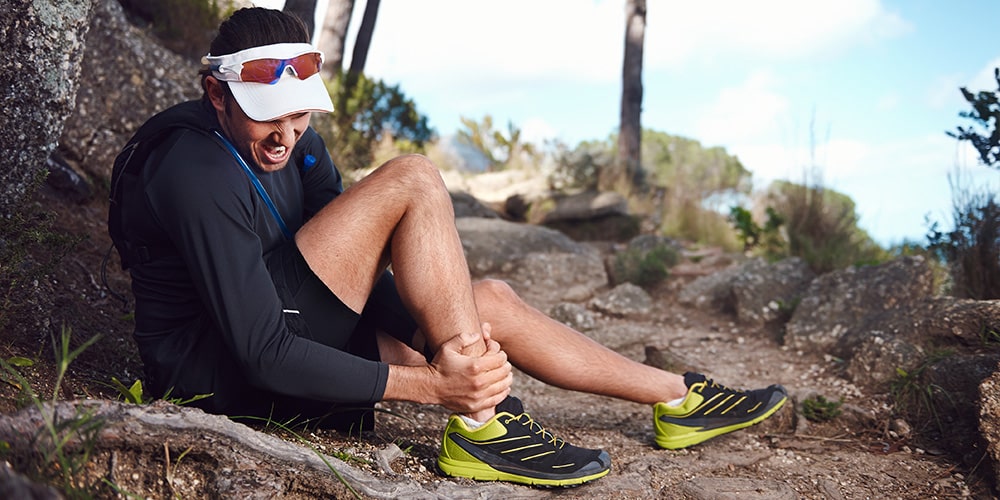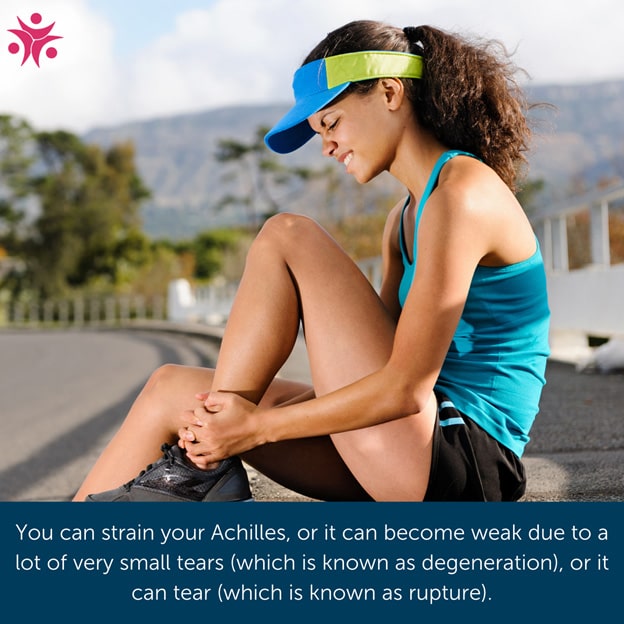
Achilles Tendonitis | A Runner and Athletes Guide
Wednesday, October 28, 2020
Named after the infamous Greek myth about Achilles and his heel, the Achilles tendon is located between our heel and calf. It's the largest and strongest tendon in our entire body and it's rather prone to injury, especially among runners.
Here, we're exploring everything you need to know about the Achilles tendon, common injuries associated with the Achilles tendon, and how to prevent and treat Achilles tendinitis, the most common Achilles tendon injury.
Anatomy of the Achilles Tendon
The Achilles tendon is the terminal extension of the three posterior muscles in the lower leg: the soleus, gastrocnemius, and plantaris. The Achilles tendon attaches into the posterior calcaneus, in other words, attaching your heel and the muscles of your feet to your calf muscle.
Your Achilles tendon is the one that helps you rise to stand on your tiptoes and stretches when we flex our feet. It is made up of many fibres and tiny proteins made up of collagen. However, the ins and outs of the Achilles tendon are not fully understood.
Inflammation of the tendon, also known as Achilles tendinitis, can occur either at the insertion of the tendon at the attachment to the bone or several inches above the bony attachment of the tendon.
Statistics on Achillies Tendon Injuries
Achilles tendon injuries account for between five and twelve per cent of all running injuries, of which men are more likely to experience, perhaps due to the speed more men are able to achieve while running or other biomechanical differences between genders such as muscle mass, weight, etc.
About two-thirds of all cases of Achilles tendinitis occurs at the midpoint of the tendon which is about two inches above the heel. The remaining third of Achilles tendinitis cases occur at the insertion point that falls within only an inch of the heel.

Most Common Types of Achilles Tendon Injuries
Achilles tendon injuries can occur in athletes and non-athletes. However, Achilles tendon injuries are common among runners and those who play sports that require a lot of running like tennis, volleyball, soccer, AFL, rugby league, rugby union, basketball, netball etc.
Achilles Tendinitis
Achilles tendinitis is a common and often frustrating injury caused when your Achilles tendon becomes inflamed. Usually, Achilles tendinitis starts out as a dull ache in the Achilles tendon which gradually becomes worse while running, especially uphill or while wearing spikes.
Symptoms of Achilles tendinitis or tendinosis can include:
- Pain, swelling, tenderness or stiffness at the Achilles tendon
- Heel pain during or after exercise
- Worsened pain with running and jumping
- Worsened pain with heel strike or pushing off from the ground
- Formation of a "bump" on the back of the heel
Achilles Tendon Rupture
A rupture of the Achilles tendon can occur during a forceful push-off. Typically there is a "pop" or ripping sensation in the back of the calf, followed by pain and decreased movement of the ankle.
A suspected achilles tendon rupture requires evaluation by a sports medicine physician and may require surgery with prolonged immobilization in a leg cast and then walking boot.
What Causes Achilles Tendinitis in Runners?
Overuse or overloading of the Achilles tendon, from either too much volume or too high of an intensity of activity is a common cause of Achilles tendonitis.
Other common causes of chronic Achilles tendinitis include:
- Tight calf muscles
- Recent increase in running mileage or running up hills
- Over-pronation (rolling in of the foot)
- Over-supination (rolling onto the outer foot)
- High foot arches (pes cavus) and flat feet (pes planus)
- Running on concrete and other unforgiving surfaces
- Overuse
- Poor range of motion in the ankle
Risk Factors for Achilles Tendon Injuries
Aside from running long distances, lots of uphill running, or sports-related factors, there are some other risk factors for developing an Achilles tendon injury including:
- Age: Injuries to the Achilles tendon are most common for people over 30
- Gender: More common among males
- Weight: Those with higher body weight are more susceptible to experiencing an Achilles tendon injury
- Diabetes: People with diabetes are more likely to experience Achilles tendon injuries
- Tight or weak calf muscles
- Poor calf muscle endurance
- Poor core stability
- Poor hip and knee stability
- Stiff joints in the feet
As for athletic risk factors, they include:
- Running too far for too long
- Running at too high of an intensity
- Increasing the distance of runs too soon
- Lack of cross-training and variation in training
- Low-quality or old runners
- Too much uphill running
Prevention of Achilles Tendonitis and Tendinosis
Most Achilles tendon injuries occur as the result of a "too much, too soon" approach or poor biomechanics. If you're looking for ways to avoid Achilles tendinitis or other Achilles tendon injuries, they can be prevented with these simple tips and listening to your body.
Achilles tendon injuries can be prevented by:
- Avoiding overtraining
- Allowing for adequate recovery and rest
- Following a regular stretching and strengthening program
- Selecting proper running shoes for your running style
How to Treat Achilles Tendinitis in Runners
The tricky thing about our tendons is that they don't heal as quickly or as completely as we might like them to. It's for that reason that Achilles tendinitis and other Achilles tendon injuries are extremely debilitating and are some of the worst injuries runners and athletes can experience.
Now, that's not to scare you into never running again or avoiding all sport. There are certainly ways to treat Achilles tendinitis, although it may take a while to see results. Again, the best treatment for Achilles tendon injuries is prevention.
Physiotherapy for Achilles Tendinitis
It's smartest to work with a physiotherapist to help treat any Achilles tendon pain, tendinitis, or other injuries. A physio will go over your medical history, conduct a series of assessments to make a proper diagnosis, note your strengths and weakness, and create a customised treatment plan.
The main goals of any physiotherapist when treating your Achilles tendinitis will be:
- Pain relief
- Regaining proper movement in the ankle
- Improved muscular strength and balance
Here are some examples of what you'll work on with your physio during your Achilles tendon treatment:
- Ankle strengthening and mobility exercises to prevent pronation and supination
- Calf strengthening exercises
- Heel drops (standing on the edge of a step, letting your heel drop to stretch the Achilles tendon)
- Using foam rollers to massage the myofascial tissue of the calves, although the tendon itself shouldn't be massaged
- Shin muscle stretches
- Icing after a run or workout
- Using a brace to protect the Achilles tendon
- Adjusting your running form
- Balance and stability training
You might also be wondering when you can get back to running during your Achilles tendon treatment. The truth is, you can continue running during treatment so long as you don't have any flare-ups.
If your Achilles tendon becomes painful and inflamed after running, it's best in the long-term to rest by taking a break from running in the short-term.
In some extreme cases like with a ruptured Achilles tendon, surgery may be necessary.
Overall, your physio will constantly check-in with your progress and moderate your results to make sure your Achilles tendinitis treatment plan is on track, noting whether the plan requires adjustment. Your physio will understand what changes should be made to ensure the best results.
Best Runners for Achilles Tendinitis
If you're a serious runner or an athlete of any kind, you'll know how important it is to wear the proper shoes. Therefore, there are certainly runners that are best for Achilles tendinitis.
Good runners are important to preventing Achilles tendinitis because of one of its major causes, pronation or supination. When your foot is pronated, it means your feet are rolling inward and when your foot is supinated, it means your feet are rolling out.
Pronation and supination both adversely affect your Achilles tendon. It causes a slight bend in the tendon itself which can further irritate the area, especially after extended use.
When shopping for a new pair of runners that are the least likely to cause Achilles tendinitis flare-ups, here's what to look for:
- Choose runners with a slight lift in the heel
- Avoid flat shoes to run in
- Avoid high heels
- Go for runners that are supportive based on the shape of your foot
- Consult with a professional to help you find the best runners for your Achilles tendinitis
You might also consider adding customised orthotics to put in your shoes for arch support and to help prevent pronation and supination of the feet and ankles.
Also, be sure to switch out your runners every so often since old shoes can also cause Achilles tendon issues.
The best advice is to seek early advice from your Physio Inq Physiotherapist to do all you can to avoid Achilles tendinitis or worse, a nasty rupture happening in the first place. Prevention is and always will be the best practice.
Call us today to book a session with one of our skilful physios who can either come to you with our mobile physio services or at one of our convenient clinics throughout Australia.
This article was originally written by Jonathan Moody from Physio Inq

